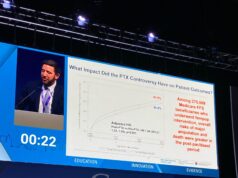
Interventional News has learnt that interventional radiologists and urologists in France are teaming up to set up a multidisciplinary registry to collect data on prostatic artery embolization for the treatment of benign prostatic hyperplasia.
Marc Sapoval, professor of clinical radiology and chair of the Cardiovascular Radiology department, Hôpital Européen Georges-Pompidou in Paris, France, said: “The French registry will assess the safety and efficacy of prostatic artery embolization. Patients referred for bothersome lower urinary tract symptoms (LUTS) who are contraindicated to, or refuse, surgery, and those with chronic urinary retention or bleeding of prostatic origin will be included. The registry will be co-managed by the French interventional radiology and urological scientific societies (SFR and AFU) and will use an online case report form. It will be launched in the third quarter of 2015.”
A similar multidisciplinary registry in the UK, the UK-ROPE, is funded jointly by the National Institute for Health and Care Excellence (NICE), the British Society of Interventional Radiology (BSIR) and the British Association of Urological Surgeons (BAUS). The registry documents patient selection criteria; all complications, specifically sexual dysfunction, and efficacy outcomes and includes measures of urinary function, symptoms and quality of life.
In the UK registry, two cohorts will be compared; one that undergoes surgical treatment and the other that undergoes prostate artery embolization. “Whilst not a randomised controlled trial, these two cohorts will be matched for age, prostate size and symptoms as is practicable. Surgical treatments will include transurethral prostatectomy (TURP), holmium laser prostatectomy (HoLEP) and open prostatectomy,” Nigel Hacking, interventional radiologist at University Hospitals Southampton, UK, told Interventional News in 2014.
Prostate artery embolization using PErFecTED technique
A single-centre, prospective study presented at the European Congress of Radiology (ECR, 4–8 March, Vienna, Austria), found that prostatic artery embolization using the PErFecTED technique does improve lower urinary tract symptoms with no significant complications.
Francisco Carnevale et al have previously described the PErFecTED technique for benign prostatic hyperplasia in the CardioVascular and Interventional Radiology (CVIR).
As described in the journal:“Prostatic artery embolization requires a refined technique to achieve good imaging and clinical success. The PErFecTED (Proximal embolization first, then embolize distal) technique has produced greater prostate ischaemia and infarction than previously described methods with clinical improvement of lower urinary symptoms and lower recurrence rates. The microcatheter should cross any collateral branch to the bladder, rectum, corpus cavernosum, or penis and be placed distally into the prostatic artery before its branching to the central gland and peripheral zone. This technique allows better distribution of embolic material in the intraprostatic arteries and reduces risk of spasm or thrombus. Because benign prostatic hyperplasia develops primarily in the periurethral region of the prostate, the urethral group of arteries should be embolized first. Subsequent distal investigation and embolization completes occlusion and stasis of blood flow to the prostatic parenchyma. Since we added the second step to the PErFecTED technique, we have observed infarcts in all patients submitted to prostatic artery embolization,” the authors write.
“The PErFecTED technique as recently described by Carnevale et al is a two-step process during embolization of each prostatic artery. As soon as the microcatheter is selectively in place inside the prostatic artery, there is a ‘proximal embolization’, with a delivery of microparticles until complete stasis. Then the tip of the microcatheter is pushed further inside the prostatic artery (in the medial branch) in a distal position, and after a digital subtraction angiography run showing the reappearance of prostatic blush, there is a second step of ‘distal’ embolization, again until complete stasis,” Gregory Amouyal from the Hôpital Européen Georges-Pompidou team, who presented the study.
He also told delegates that long-term follow-up is needed to confirm the durability of prostate artery embolization.
Patients with symptomatic benign prostatic hyperplasia were included after failure of medical treatment if they refused surgery and had a prostate volume >40mL. The study evaluated data from 25 consecutive patients (mean age 65) treated between December 2013 and November 2014 after urological and interventional radiological baseline assessment.
Patients underwent hyperselective prostatic artery embolization with 300-500µm trisacryl microspheres, under local anaesthesia, as an outpatient treatment, or with a short one-night hospital stay.
The primary endpoints for clinical success were: International Prostatic Symptom Score (IPSS) -25% or ≤18, Quality of life score reduction of at least one point or ≤3, or peak urinary flow rate (Qmax) -25% or ≤7mL/s at three or six-month follow-up.
The investigators had 100% technical success and no major complications (such as vesical or rectal necrosis). They observed post-embolization syndrome including mild fever and pollakiuria in all patients. At the three-month follow-up, there was data of clinical success for 19 out of 25 patients. At the six-month time frame, there was follow-up information and clinical success for 13 out of 18 available patients. “After a mean follow-up of 5.1 months, we observed significant decrease in IPSS (59%), QoL (-2.8) and prostatic volume (-24%). We had no retrograde ejaculation after prostatic artery embolization,” Amouyal said.












